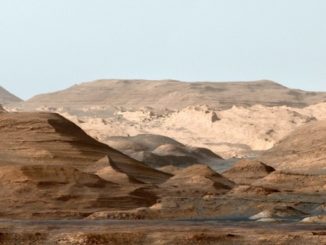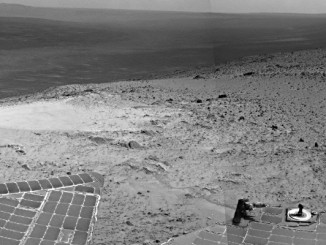When not taking shelter to hide from dangerous dust spewing from comet C/2013 A1 (Siding Spring), the flotilla of spacecraft orbiting Mars will be turning their instruments in two directions – one towards the comet, and the other towards Mars itself, to find out what happens when a planetary atmosphere brushes against the fuzzy atmosphere of a comet.
One possibility, as the comet dust rains down on the red planet, is that there could be so much dust that Mars might see five-years’ worth of meteor activity in just a few hours. How dramatic these meteor showers will appear from the ground, where they could be seen by the Mars rovers Opportunity and Curiosity, is unknown. Nevertheless, this influx of dust should warm Mars’ middle atmosphere, causing it to inflate, while dust particles will act as condensation nuclei for clouds where normally clouds do not form. Meanwhile, scientists will want to learn as much as they can about the coma itself: how big it is and how it is fed by dust outflows from the surface of the comet.
The Mars Reconnaissance Orbiter has already initiated observations of comet, days in advance of Siding Spring’s closest approach. Principally it is employing its HiRISE camera, which usually spends its time looking at Mars and taking stunning high-resolution imagery, as well as its spectrometer CRISM (Compact Reconnaissance Imaging Spectrometer for Mars) to study the coma’s composition. Mars Express has followed suit with its high-resolution camera, while on 14 October MAVEN began measurements at ultraviolet wavelengths, imaging the coma and determining its deuterium to hydrogen ratio. This latter observation has particular importance for the origin of Earth’s water. Were our oceans created by water delivered to our planet by impacting asteroids, or by comets? Earth’s water has a specific isotopic ratio – is this matched by the water contained within comets? Previous observations of comets show that some comets do match the deuterium/hydrogen ratio in Earth’s oceans, but others do not. However, too few comets have really been studied in this fashion and so it is important to investigate more.

MAVEN, newly arrived at the red planet, is still in its commissioning phase, so this is a unique opportunity to test its instruments. “We’re not going to be ready to do full-on science, but we are taking several days out of our commissioning schedule in order to try and do observations of the comet and of Mars’ upper atmosphere before and after it gets hit by any dust or gas,” says Bruce Jakosky, MAVEN’s Principal Investigator.
As the comet’s coma and tail begin to encroach upon Mars, robotic eyes will be diverted towards the planet. Mars Express’ SPICAM instrument, which is an ultraviolet and infrared atmospheric spectrometer, will watch for signs of Mars’ atmosphere inflating in response to comet dust by observing six stellar occultations and conducting four limb surveys. If the atmosphere swells, these occultations as the stars pass behind Mars will happen earlier than expected. However, the comet arrives at the planet at a time when Mars is prone to dust storms and the dust raised from the ground will also affect the atmosphere, potentially confusing readings.
Scientists are interested in the comet’s nucleus, but it is so small, just 700 metres across, that viewing it will prove difficult – as Mars scientists have been quick to point out, there will be no Rosetta-style close-up images here. Still, the HiRISE camera on the Mars Reconnaissance Orbiter will attempt to image the nucleus, or at least see its silhouette against the coma, while Mars Odyssey will use its thermal emission spectrometer to attempt to try and detect the comet as it departs from the vicinity of Mars. The main aim of the nucleus observations is to determine how dark the comet actually is. Most of the cometary nuclei that we have seen so far have been some of the darkest bodies in the Solar System, which seems a bit ironic considering their bright coma and tails. The question is, do they only become dark after repeated visits to the inner Solar System, or are they formed dark and what does this tell us about both their composition and the composition of the Oort Cloud? This rare encounter with a comet that is on its first voyage into the inner Solar System from the distant Oort Cloud will hopefully be able to provide some of the answers. Says Jakosky, “As one of my MAVEN team members said, it is such an exciting science opportunity that the observations would be worth a mission in itself, to get the chance to observe the comet and Mars’ atmosphere in response.”




